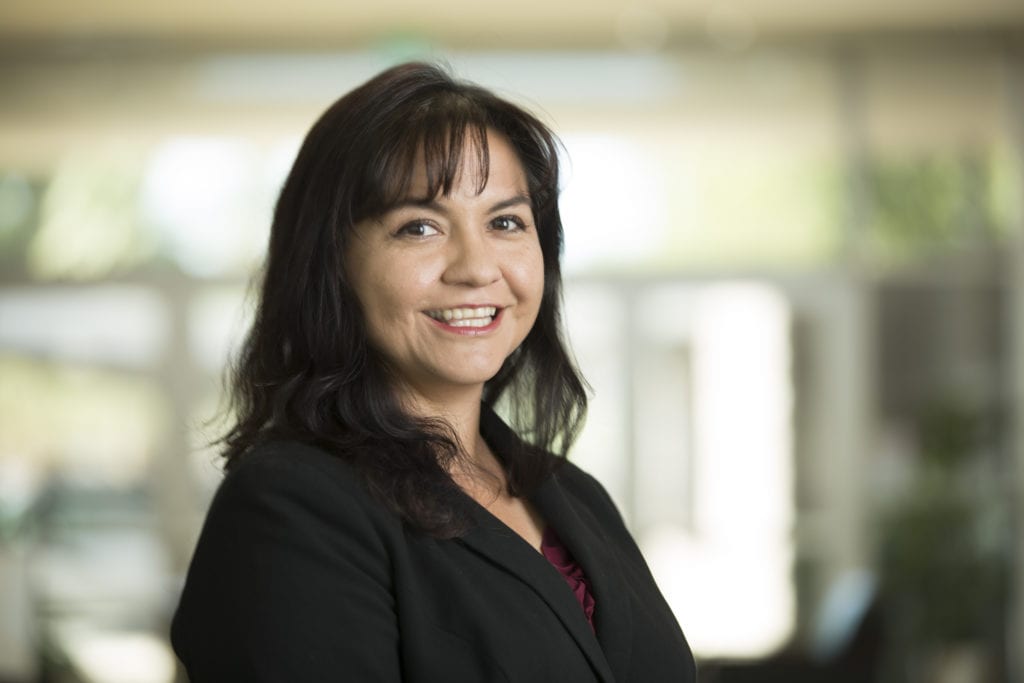By Brian Powell
Flinn Foundation

Diana Gomez has spent a lifetime living in—and a career serving—Yuma County.
Gomez, a Flinn-Brown Civic Leadership Academy Fellow, was born and raised in Yuma and has worked for the county’s public health district for 22 years, including the last seven as chief health officer.
As chief health officer and director of public health for Yuma County, Gomez oversees efforts to prevent epidemics and the spread of communicable diseases, advocate health policies, enforce public health law, and protect against environmental hazards.
She works with the Yuma County Board of Supervisors and across the border with public health officials from Sonora, Mexico, while also serving on regional, state, national, and binational committees, councils, and workgroups.
“It’s such an incredible privilege to serve my community. These are my neighbors, parents, friends, and I have a sense of pride and responsibility to do right; you would anyhow, but it’s very personal, because I grew up here,” Gomez said.
Yuma County
Yuma County sits in the southwestern corner of the state and includes a border with Mexico, the Marine Corps Air Station Yuma and U.S. Army Yuma Proving Ground, the Fort Yuma-Quechan and Cocopah tribal nations, plus an annual influx of winter visitors and migrant farmworkers. The year-round population is about 200,000, but increases by about 90,000 in the winter, according to the county. Yuma County is also known as the “Winter Vegetable Capital of the World” and has earned the distinction of being the “Sunniest Place on Earth” according to the World Meteorological Society.
Gomez represents the diverse Yuma County population on multiple state committees and national work groups, including the Arizona Local Health Officers Association, whose goal is to strengthen the public health infrastructure across Arizona to protect and improve the health of communities across the state.
Gomez serves as co-president of the Binational Health and Environment Council, which works on prevention efforts and other health activities along the U.S.-Mexico border. The binational cooperation includes surveillance and health promotion campaigns aimed at preventing and mitigating mosquito borne illness, and the treatment and identification of communicable diseases and chronic health conditions. For instance, the Yuma County Health District and Secretaria de Salud of Sonora, Mexico, partnered on a project to have blood-pressure stations on both sides of the border to emphasize the importance of cardiovascular health.
Gomez says she values the working relationship with the Secretaria de Salud of Sonora and acknowledges that their collaborative efforts are critical to ensuring the health and wellness of citizens on both sides of the border community.
The University of Arizona graduate serves as an appointee by Gov. Doug Ducey to Arizona’s South Regional Advisory Council for Homeland Security, which includes Yuma, Pima, Santa Cruz, and Cochise counties. The council, which includes first responders, law enforcement, elected officials, and public health experts, prioritizes Homeland Security projects for the border region and makes recommendations for federal funding.
Gomez is also involved in efforts to attract more clinical professionals to Yuma County—where there is a physician shortage greater than in the state’s urban areas—as well as develop more locally.
Flinn-Brown Experience
Gomez is one of five Flinn-Brown Fellows from Yuma County, among them a mayor and county supervisor, two county employees, and the director of a UArizona agriculture center.
“It was one of the best decisions I made. It was an incredible experience to talk with other people across the state, not only to learn different perspectives but to see how much we have in common,” says Gomez, who was encouraged to apply for the Flinn-Brown Academy by a Yuma County colleague.
Gomez said her Flinn-Brown cohort discussed topics ranging from the state’s opioid epidemic to early-childhood education to transportation. The seemingly disparate issues, however, can all have an impact on public health and were relevant to her work in Yuma County, she says.
“Seeing how all those issues relate was a big ‘a-ha’ moment
because you can be so siloed,” Gomez says.
The program has inspired Gomez to remain active at both the state, national, and
binational level. She also has not ruled out a run for public office one day.
Flinn-Brown Network
About four times a year, the five Flinn-Brown Fellows from the Yuma area meet for lunch. The Yuma group is part of the larger Flinn-Brown Network, which features more than 350 Fellows statewide from differing perspectives and walks of life—with more than 90 percent living in Arizona.
Gomez said because of distance it is difficult to attend most Flinn-Brown Network functions, such as a Tucson happy-hour gathering for southern Arizona Fellows, or continuing civic-education opportunities offered at the Flinn Foundation in Phoenix. Yet, beyond the Yuma gatherings, Gomez feels a strong connection to the Flinn-Brown Network.
“I feel really comfortable picking up the phone or sending out a message to any of my colleagues that I’ve met through Flinn-Brown,” she says.
The 2020 Flinn-Brown Civic Leadership Academy, featuring 14 seminars, will begin in August and end in November 2020. The application will open in the spring.
An introductory program, CivEx, or the Arizona Civic Exchange, features four half-day discussions about state issues for those interested in becoming more involved in civic life, including potential candidates. The next CivEx series will be held in January and February. The registration period will open in early December.
Learn more about Flinn-Brown and the Arizona Center for Civic Leadership at www.azcivicleadership.org.